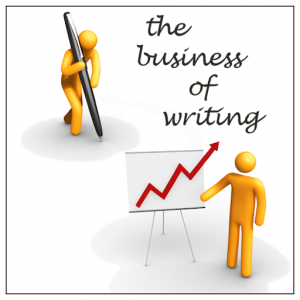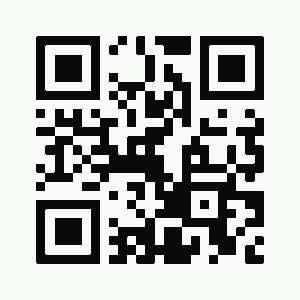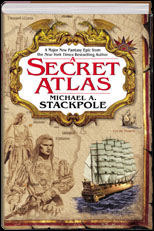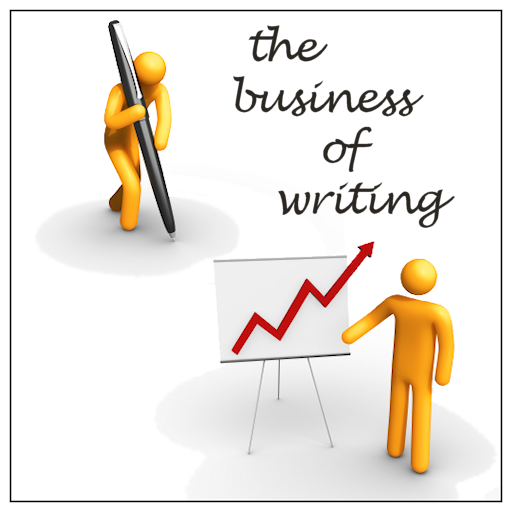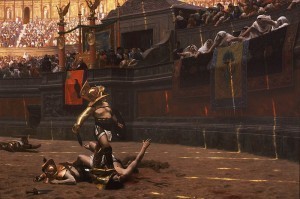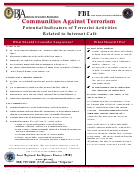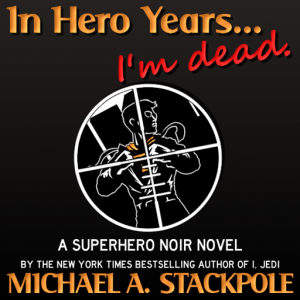Michael A. Stackpole's Blog, page 7
February 29, 2012
Golden Rule: He who has the gold makes the rules.
A couple days ago I posted a Twitter link to an article in the Huffington Post titled: PayPal Takes Controversial Stance Against Sex. The article reveals that Paypay has told a number of websites selling erotica that if they continue to sell work that features bestiality, incest (or pseudo-incest) or underage sex, Paypal will suspend their accounts.
I fully concur with anyone who notes that Paypal, as a private business enterprise, has every right in the world to decide with whom they do business. We can all agree that their severing ties with any criminal enterprise makes sense. If someone were selling crack by mail, using Paypal for transactions, suspending the accounts of both users and sellers would make sense. And, for their part, Paypal has to be very alert to charges of being money launderers. One Ebay sales for an overpriced piece of junk could, in fact, be the conduit for getting money into the hands of terrorists under the watchful eye of the government. So, I'm all for Paypal being watchful—and full disclosure here, I use Paypal to accept payments for my site.
Here's where I'm uncomfortable. The prohibition against bestiality includes, in paranormal romances, a prohibition against were-creatures engaging in sex while in beast form. Unless I misremember, this, then, would make the selling of the movie Bram Stoker's Dracula prohibited, since I recall a werewolf having his way with a woman in a graveyard. And, hey, if not in that film, how about the legion of other horror films where that sort of thing happens? Sure, someone from the Paypal side could argue that the scene I remember isn't explicit, but who becomes the final arbiter of what is or isn't explicit in that regard?
Bear in mind, please, that even the most explicit sex in media is not necessarily illegal. It is, whether you like it or not, protected speech.
Here's a case that hits a bit closer to home. Back when I was writing the Age of Discovery series, the editor and I had a disagreement about a point concerning the love story between two characters. I noted that they'd met when she was fourteen year old concubine and begun their romance. The editor objected, suggesting this was an inappropriate age for the romance to start. I tried to point out that the age of consent is not uniform in the world, and not even in the USA. With parental or judicial agreement, girls as young as 14 are allowed to marry.
Still, she wouldn't have it, so the age reference got deleted, and I merely referred to the female as a young woman. And, note, the protest wasn't about her being a concubine at that age, it was about her being able to consent to a relationship which, as it turned out, lasted for centuries. Also we're not talking modern times—in which adolescence is artificially extended by society—or even this world.
Let's put this into some historical perspective, to use but one of many examples. In 1137, the one-year-old Petronilla of Aragon was betrothed to a twenty-four year old man, Ramon Berenguer IV of Barcelona. Fourteen years later they were married (she being fifteen, he being thirty-eight) and produced five children in the dozen years before Ramon died. (Example is drawn from Norman Davies' wonderful book Vanished Kingdoms.)
The question then, to return to the point, is this: would a historical romance based on the Petronilla and Ramon story trigger a Paypal warning?
It's not that easy an answer, is it? It depends fully who is doing the judging. It would be easy to say, "no" because history justifies it. And perhaps the author, while showing them lovemaking on their wedding night, is gently explicit as in softer romances. Others might note that despite her age, she was married and, therefore, that makes it okay—while another arbiter who believes the Catholic Church is really the Whore of Babylon, would see the marriage's sanction as being another example of Satanic influence in the world and protest.
I also think we'd all be foolish to forget that outside influences might pressure arbiters to make decisions with which we disagree. Advocacy groups with their own axes to grind have very successfully organized secondary boycotts, which gotten corporate decisions reversed and television programs either removed or renewed. Such efforts saved Chuck, and have gutted some truly horrible shows.
I think that each of us needs to consider what Paypal's done and realize they've begun inching down a very slippery slope. In my opinion, once they begin to pressure businesses engaging in legal activity to curtail those activities, they're setting themselves up to be moral arbiters for the culture—or, by proxy, instruments of special-interest groups who want to be moral arbiters. I never saw that as part of their business mission statement. Maybe it's time to buy some Ebay stock and voice my opinion as a stockholder.
Because, ultimately, just the very fact that I've written and published this essay critical of Paypal could be cause enough for them to notify me that if I don't pull it, don't recant, they'll cut me off. And if I don't, and they pressure my ISP to kill my site…
Very slippery slope.
UPDATE: The Passive Voice Blog has linked to a follow-up article on this whole thing: Paypal Loosens Grip…
February 24, 2012
Join the Stormwolf Mailing List
In this new world of digital distribution, I'm turning out a fair amount of work which is digital-original. I mention it in blog posts and on Twitter and Facebook. I realize that I've really missed the boat, all these years, by not putting together a mailing list for folks where I can shoot off an email to let them know a new product is available. The problem with blog posts and tweets and Facebook mentions is that they scroll off so fast these days, folks miss them. (The alternative is a constant stream of reminders, which gets old VERY fast.)
You can join my mailing list by hitting this link, or by clicking on the QR code above. This will send you to a Mailchimp sign-up page, and you'll get an email confirming your subscription. (I found Mailchimp because the Macallan distillery uses them. Why not go with the best, right?)
A couple of notes:
1) Only sign up if you're interested in being notified when I have new work available for purchase. Let me make no bones about it—this is a commercial list, not a news list. News I'll still shoot out on Twitter and Facebook and post here. If you want to make sure you don't miss new releases, this is the list you want to be on.
2) I will not give away your information or share it with anyone else. The only person authorized to send email to this list will be me.
3) I might include, in an email that refers to a product of mine, a mention of a product by another author or friend. I'll only do this in the case of products I think you'll enjoy, and I'll be doing it because I like the project. I'm not selling access to the list or inclusions in emails. That would just be tacky.
4) You'll get no more than one email a month on this list, and certainly no more than a dozen in a year. (Probably fewer.) Again, this list will just contain news of products of mine that you'll be interested in buying, reading and/or playing.
5) To reiterate: this list is just for folks who want to be a Patron of the Arts and snag stuff when it comes out. I really do appreciate your patronage. It keeps a roof over my head, and the products you buy determine what I'll be turning out. Voting with your dollars really works in that regard.
Mailchimp makes a basic account available for free up to 2,000 users. In the event that you push it over that limit, I'll find a way to cope. 
Thanks.
February 21, 2012
E-book Design doesn’t have to be bad
A Twitter message of outrage over e-book pricing from @feliciaday (yes, that Felicia Day) reminded me of an embarrassing incident from the holidays. I’d put it out of my mind largely due to hysterical amnesia. You’ll see why in a second.
For Christmas my brother, sister and I kicked in to get my parents an iPad 2. My father had mentioned being interested in having an e-book reader, and he liked backlit screens. He’s a Mac user (since I’m his IT guy, I insisted). My mom is still rather 19th century about tech, but she’d played with my iPad and is very much into pictures of her grandchildren. The display and ability to load digital pictures straight into the iPad without having to wait for my father to load them onto the computer, were big selling points. Part of the deal was that I would help them get used to the device while I was visited for Christmas.
Phase one of computer camp started with my father. He wanted me to walk him through iBooks and how to order books. I showed him the search function and, of course, we searched on my name. (Have to reinforce the brand there, after all.) A bunch of my books came up and we tapped on the first one on the list: A Secret Atlas. We ordered the sample, then opened it.
I was very embarrassed by the product.
A quick note here: I’ve purchased multiple e-books from traditional publishers. While many of the new books look pretty solid, the problems I will point out below are endemic to backlist titles. These books get scanned wherever the work can be done cheaply (usually off-shore to places like India), and are put into shape using design specs that are now at least two generations behind in terms of e-book design. It’s the electronic equivalent of publishers putting their backlist out on clay tablets. While I use A Secret Atlas as an example, it’s not because of any ax to grind with Random House. It’s just that with that book the contrast between it and the physical book are incredibly sharp.
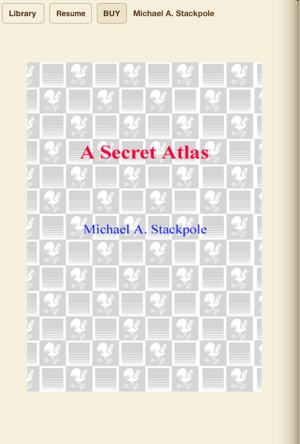 Cover: The thumbnail of the print cover of A Secret Atlas shows up just fine in the iBooks library. The image at the left, however, is what you get if you click on the Table of Contents button. Not only does it look like crap, but the correct cover graphic is already part of the e-book file. Not only does this bulk out the file (raising Amazon’s download charge to the publisher), but it’s completely wasted data. Just put the book’s real cover there.
Cover: The thumbnail of the print cover of A Secret Atlas shows up just fine in the iBooks library. The image at the left, however, is what you get if you click on the Table of Contents button. Not only does it look like crap, but the correct cover graphic is already part of the e-book file. Not only does this bulk out the file (raising Amazon’s download charge to the publisher), but it’s completely wasted data. Just put the book’s real cover there.
Table of Contents: I have complained about this aspect of things before with traditionally published e-books. Their design specs demand a fully interactive Table of Contents in the front of the book, right where it would appear in a traditional book. It should be noted that the print versions of A Secret Atlas do not have a Table of Contents, so this was cobbled together specially. This Table of Contents consists of page after page of hotlinks going directly to chapters.
As if anyone is going to page back through the book to get to it! You can’t, save by flicking every single page. Right up there in the upper left corner, between the Library button and the Buy button, you can find the Table of Contents button (where the Resume button is in the picture). You cannot make an e-book without one of them being generated automatically! It is available from every single page in the book. The only way you can get to their hotlink table of contents, unless you want to page back through the book, is to use the automatically provided table of contents. More wasted time and effort in generating something no one will use.
Front Sales Material: Another point I have made concerning e-books is this: publishers should put a list of other books available from the author, with hotlinks enabled, in the front of the e-book. Why? Because when someone downloads the free sample, as I did, they’d get a whole list of other books by the same author. This is simply good business. The print version of A Secret Atlas has an extensive list of other books I’ve written, right up there in the front of the book. There is no reason on earth why that should not have been included, with hotlinks.
Unless, of course, compiling that information would be too much work. The fact that it might sell more books should be a mitigating factor there, I would think.
Title Page: In the print version of A Secret Atlas the title page was beautiful. So, for the e-book version they simply shot .jpg of it and included it. The problem is that the title page was part of a two-page spread, which shows up as two separate, non-side-by-side, pages in the e-book. (That is a problem with the dimensions of the .jpg, I suspect.) So, instead of redesigning the title page so it looks nice, they leave it looking like a cut-and-paste job done by Ms. Finster’s afternoon art class at NimbleKinder Day Care.
The Map: As you can guess from the title, A Secret Atlas has something to do with maps. Bantam got the artist Michael Gellatly to do a lovely map based on my original sketches. It’s reproduced faithfully in the e-book. It’s wider than it is tall, so they put it on its own page. The writing on the map, unfortunately, is oriented vertically, not horizontally (ditto the compass).
What ensues, in trying to read the map, is hilarity, at least if you’re reading on a tablet device that switches orientation. As you turn the device to read the map correctly, the map revolves so you can’t. And, yes, it’s true that many devices allow you to lock the orientation, but the default isn’t set that way on an iPad, so I’d have to go digging around to repurpose that button. That repurposing is global, not specific to iBooks, so I’d have to switch it back if I want the button to work as a mute button again.
Nice idea with the map, including it that is, but a big, practical fail when it comes to the reality of reader devices.
General Formatting. It’s no secret that e-books are really just clumsy HTML pages all packaged together for convenience. However, this does not mean that a book needs to look like a web page. To give Bantam their props, they did ask for indenting on paragraphs. That looks good.
What looks like hell, and I see this all the time in lousy e-books, is an extra line between paragraphs. That’s what a web page looks like. E-books don’t have to. I don’t do that in my books. And the place where you see it most in A Secret Atlas is in the chapter headers. What should be a compact little collection of lines now takes up over half a page. What should have been almost invisible now has to be waded-through. It’s just one hot mess.
As noted above, this is not about Bantam or Random House. I’ve seen the same sort of things in books from plenty of imprints. It’s indicative of a general indifference to the e-book reading audience and a willful ignorance of how e-books work and what readers want. And since, at latest guesstimates, at least 30% of publishing’s income is coming in from e-book sales—and rising—they’re really past the point of creating a good impression. Smaller, leaner houses, more able to move with the times, will be setting the standards against which they will be judged. Individual authors can do that, too—I’ll let you know when I have the e-book version of Eyes of Silver ready and you’ll see what one guy can do with a bit of imagination and some basic book design knowledge.
Readers should take note: authors have absolutely no control over what our e-books look like. I’ve asked publishers if they’d let me do my own version of my books, just so they’ll look good. The silence of their responses is chilling. (The time to redo A Secret Atlas would be inside of an hour.)
The attitude of “if they want it, they’ll buy it no matter what” has contributed heavily to traditional publishing’s current straits. Claims of being the gatekeeper get undercut badly when production efforts show contempt and lack of respect for the folks who pay their bills.
_______________________
Writing up this series of blog posts is cutting into my fiction writing time. If you’re finding these posts useful, and haven’t yet gotten yet snagged my latest novels, please consider purchasing a book. Nice thing about the new age of publishing is that you become a Patron of the Arts, letting writers know what you’d like to see more of simply by voting with a credit card. (Authors charge less when they sell direct, so you save, we make more, and that frees us to write more.)
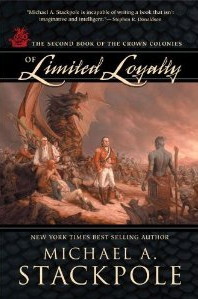 My latest paper novel, Of Limited Loyalty, is due out in December and is available for pre-order now.
My latest paper novel, Of Limited Loyalty, is due out in December and is available for pre-order now.
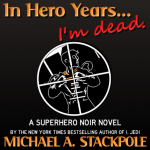
My digital original novel, In Hero Years… I’m Dead is available for the Kindle and in the epub format for all the other readers, including the Nook, iPhone, iPod Touch and iPad. (Imagine the Batman, Watchmen and Kick-Ass movies all rolled into one, as written by Dashiell Hammett, and you’ve pretty much got the idea of the book. Oh, and with some satire and political commentary slipped in for irony.)
E-book Design doesn't have to be bad
A Twitter message of outrage over e-book pricing from @feliciaday (yes, that Felicia Day) reminded me of an embarrassing incident from the holidays. I'd put it out of my mind largely due to hysterical amnesia. You'll see why in a second.
For Christmas my brother, sister and I kicked in to get my parents an iPad 2. My father had mentioned being interested in having an e-book reader, and he liked backlit screens. He's a Mac user (since I'm his IT guy, I insisted). My mom is still rather 19th century about tech, but she'd played with my iPad and is very much into pictures of her grandchildren. The display and ability to load digital pictures straight into the iPad without having to wait for my father to load them onto the computer, were big selling points. Part of the deal was that I would help them get used to the device while I was visited for Christmas.
Phase one of computer camp started with my father. He wanted me to walk him through iBooks and how to order books. I showed him the search function and, of course, we searched on my name. (Have to reinforce the brand there, after all.) A bunch of my books came up and we tapped on the first one on the list: A Secret Atlas. We ordered the sample, then opened it.
I was very embarrassed by the product.
A quick note here: I've purchased multiple e-books from traditional publishers. While many of the new books look pretty solid, the problems I will point out below are endemic to backlist titles. These books get scanned wherever the work can be done cheaply (usually off-shore to places like India), and are put into shape using design specs that are now at least two generations behind in terms of e-book design. It's the electronic equivalent of publishers putting their backlist out on clay tablets. While I use A Secret Atlas as an example, it's not because of any ax to grind with Random House. It's just that with that book the contrast between it and the physical book are incredibly sharp.
 Cover: The thumbnail of the print cover of A Secret Atlas shows up just fine in the iBooks library. The image at the left, however, is what you get if you click on the Table of Contents button. Not only does it look like crap, but the correct cover graphic is already part of the e-book file. Not only does this bulk out the file (raising Amazon's download charge to the publisher), but it's completely wasted data. Just put the book's real cover there.
Cover: The thumbnail of the print cover of A Secret Atlas shows up just fine in the iBooks library. The image at the left, however, is what you get if you click on the Table of Contents button. Not only does it look like crap, but the correct cover graphic is already part of the e-book file. Not only does this bulk out the file (raising Amazon's download charge to the publisher), but it's completely wasted data. Just put the book's real cover there.
Table of Contents: I have complained about this aspect of things before with traditionally published e-books. Their design specs demand a fully interactive Table of Contents in the front of the book, right where it would appear in a traditional book. It should be noted that the print versions of A Secret Atlas do not have a Table of Contents, so this was cobbled together specially. This Table of Contents consists of page after page of hotlinks going directly to chapters.
As if anyone is going to page back through the book to get to it! You can't, save by flicking every single page. Right up there in the upper left corner, between the Library button and the Buy button, you can find the Table of Contents button (where the Resume button is in the picture). You cannot make an e-book without one of them being generated automatically! It is available from every single page in the book. The only way you can get to their hotlink table of contents, unless you want to page back through the book, is to use the automatically provided table of contents. More wasted time and effort in generating something no one will use.
Front Sales Material: Another point I have made concerning e-books is this: publishers should put a list of other books available from the author, with hotlinks enabled, in the front of the e-book. Why? Because when someone downloads the free sample, as I did, they'd get a whole list of other books by the same author. This is simply good business. The print version of A Secret Atlas has an extensive list of other books I've written, right up there in the front of the book. There is no reason on earth why that should not have been included, with hotlinks.
Unless, of course, compiling that information would be too much work. The fact that it might sell more books should be a mitigating factor there, I would think.
Title Page: In the print version of A Secret Atlas the title page was beautiful. So, for the e-book version they simply shot .jpg of it and included it. The problem is that the title page was part of a two-page spread, which shows up as two separate, non-side-by-side, pages in the e-book. (That is a problem with the dimensions of the .jpg, I suspect.) So, instead of redesigning the title page so it looks nice, they leave it looking like a cut-and-paste job done by Ms. Finster's afternoon art class at NimbleKinder Day Care.
The Map: As you can guess from the title, A Secret Atlas has something to do with maps. Bantam got the artist Michael Gellatly to do a lovely map based on my original sketches. It's reproduced faithfully in the e-book. It's wider than it is tall, so they put it on its own page. The writing on the map, unfortunately, is oriented vertically, not horizontally (ditto the compass).
What ensues, in trying to read the map, is hilarity, at least if you're reading on a tablet device that switches orientation. As you turn the device to read the map correctly, the map revolves so you can't. And, yes, it's true that many devices allow you to lock the orientation, but the default isn't set that way on an iPad, so I'd have to go digging around to repurpose that button. That repurposing is global, not specific to iBooks, so I'd have to switch it back if I want the button to work as a mute button again.
Nice idea with the map, including it that is, but a big, practical fail when it comes to the reality of reader devices.
General Formatting. It's no secret that e-books are really just clumsy HTML pages all packaged together for convenience. However, this does not mean that a book needs to look like a web page. To give Bantam their props, they did ask for indenting on paragraphs. That looks good.
What looks like hell, and I see this all the time in lousy e-books, is an extra line between paragraphs. That's what a web page looks like. E-books don't have to. I don't do that in my books. And the place where you see it most in A Secret Atlas is in the chapter headers. What should be a compact little collection of lines now takes up over half a page. What should have been almost invisible now has to be waded-through. It's just one hot mess.
As noted above, this is not about Bantam or Random House. I've seen the same sort of things in books from plenty of imprints. It's indicative of a general indifference to the e-book reading audience and a willful ignorance of how e-books work and what readers want. And since, at latest guesstimates, at least 30% of publishing's income is coming in from e-book sales—and rising—they're really past the point of creating a good impression. Smaller, leaner houses, more able to move with the times, will be setting the standards against which they will be judged. Individual authors can do that, too—I'll let you know when I have the e-book version of Eyes of Silver ready and you'll see what one guy can do with a bit of imagination and some basic book design knowledge.
Readers should take note: authors have absolutely no control over what our e-books look like. I've asked publishers if they'd let me do my own version of my books, just so they'll look good. The silence of their responses is chilling. (The time to redo A Secret Atlas would be inside of an hour.)
The attitude of "if they want it, they'll buy it no matter what" has contributed heavily to traditional publishing's current straits. Claims of being the gatekeeper get undercut badly when production efforts show contempt and lack of respect for the folks who pay their bills.
_______________________
Writing up this series of blog posts is cutting into my fiction writing time. If you're finding these posts useful, and haven't yet gotten yet snagged my latest novels, please consider purchasing a book. Nice thing about the new age of publishing is that you become a Patron of the Arts, letting writers know what you'd like to see more of simply by voting with a credit card. (Authors charge less when they sell direct, so you save, we make more, and that frees us to write more.)
 My latest paper novel, Of Limited Loyalty, is due out in December and is available for pre-order now.
My latest paper novel, Of Limited Loyalty, is due out in December and is available for pre-order now.

My digital original novel, In Hero Years… I'm Dead is available for the Kindle and in the epub format for all the other readers, including the Nook, iPhone, iPod Touch and iPad. (Imagine the Batman, Watchmen and Kick-Ass movies all rolled into one, as written by Dashiell Hammett, and you've pretty much got the idea of the book. Oh, and with some satire and political commentary slipped in for irony.)
February 17, 2012
Whistling Past the Graveyard: HarperCollins and Amanda Knox
I ran across a news item today about HarperCollins signing Amanda Knox to a huge book deal. Four million dollars for her tell-all biography about her ordeal in the Italian justice system. For those of you, like me, who don't have cable and haven't been following cases like this (or that of Casey Anthony) closely, the short form is that Knox, her boyfriend and another man were convicted of murdering Knox's female roommate. The prosecution suggested that the girl was murdered because she was reluctant to have group sex, etc.. Subsequent investigations pointed up irregularities with evidence and Knox's conviction was overturned.
Italian authorities are appealing the ruling which overturned the convictions.
Before I go any further, let me note for the record that I'm happy as a clam that Ms. Knox got a book deal. If folks are willing to pay her money to tell her story, I think that's great. (And if she needs a ghost…  ) I'm not sorry she got the money, nor am I morally outraged that someone's whose fame is based on an infamous crime is getting paid off. Welcome to the wonderful world of capitalism.
) I'm not sorry she got the money, nor am I morally outraged that someone's whose fame is based on an infamous crime is getting paid off. Welcome to the wonderful world of capitalism.
What has me scratching my head about this deal is this: Amanda Knox's story is past its sell-by date. The book is slated to come out next year, which means, unfortunately, there will be another pretty girl murdered, or having done the murder, which Nancy Grace and others will flog for fleeting ratings, and then they'll move on. It's old news already…
…unless the appeal is successful, and the convictions are reinstated. At that point HarperCollins will be flogging the most infamous set of self-aggrandizing and self-serving memoirs since O. J. Simpson tried to peddle his hypothetical side of his dark act. I have no doubt that possibility was raised in meetings, and I am feeling really skeevy about someone saying, "well, that will put her back in the news, so we'll just up the print run."
Because we know someone did say that.
The biggest problem here, as I see it, is that HarperCollins cannot actually expect to make that four million back. And, yes, I know they don't intend to. They figure that they can sell off translations of the book and make some of it back, but much of the benefit here is in the publicity they get from having given the girl that much money. That's how the business works, and how it's always worked.
And look where that's put traditional publishing.
Here's a suggestion: pay a little less for books from faux-celebrities, and spend a bit more on your ebook preparation and, best of all, actually publicizing good books that readers like. Great novels go out of print and never find the full audience they could because they never get a push. Instead of throwing vast money away on an unknown bet, why not double-down on a book or two that has legs and could make a lot of money for the publisher, retailers and the author?
I know, I'm a dreamer. It's just that the same-old thinking has put the industry in a very difficult spot. Right now we need out-of-the-box thinking. I know we won't get that out of trad pub, but just for fun, can't they see their way to explore a bit more inside the box? It might not save them, but it will stop them from tanking quite so quickly.
_______________________
Writing blog posts cuts into my fiction writing time. If you're finding these posts useful, and haven't yet gotten yet snagged my latest novels, please consider purchasing a book. Nice thing about the new age of publishing is that you become a Patron of the Arts, letting writers know what you'd like to see more of simply by voting with a credit card. (Authors charge less when they sell direct, so you save, we make more, and that frees us to write more.)
 My latest paper novel, Of Limited Loyalty, is out in paper. If you want it for the Kindle, just hit this link.
My latest paper novel, Of Limited Loyalty, is out in paper. If you want it for the Kindle, just hit this link.
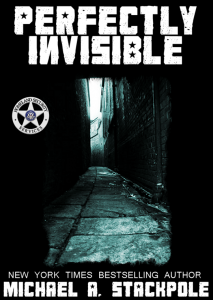 For those of you who haven't tried Perfectly Invisible yet, now is your chance. I've provided three sample chapters here on my website, or you can click on any of the online retailers below and download a free preview of the novel. You can get up to speed on Miracle Dunn and watch how the new story unfolds here as I blog about the writing. (The novel is 50,000 words long, or a five hour read for the average reader.)
For those of you who haven't tried Perfectly Invisible yet, now is your chance. I've provided three sample chapters here on my website, or you can click on any of the online retailers below and download a free preview of the novel. You can get up to speed on Miracle Dunn and watch how the new story unfolds here as I blog about the writing. (The novel is 50,000 words long, or a five hour read for the average reader.)
The full novel is available for purchase right now from my webstore. Just click on the cover image to the left, or on that link. The novel runs $3.99, and the package in my store has both the Kindle and epub versions of the books, so you'll have a copy that works with any of your readers. As always, the books are presented without DRM (digital rights management) and I have a note with instructions for getting the book onto ereaders and smartphones.
For the Kindle edition, just hit this link.
To purchase it through iTunes for your iPad/iPhone/iPod, just hit this link.
To purchase it through Barnes & Noble for your Nook, please use this link.
February 16, 2012
Thank God I'm not a swimsuit model!
A problem for any creative individual is that critiques of what we do—by friends, family (parents especially), peers, taste arbitrators and the public—can really hurt. I've taken to throwing up a first line of defense when it comes to Internet reviews—especially anonymous ones—which is to remind myself that, until proven otherwise, every Internet pundit is really twelve years old. (Chronologically, emotionally or intellectually, that is.)
But, heck, my world is heaven compared to the environment some other folks face. I hit an article about Kate Upton, the new Sports Illustrated cover model for their swimsuit issue. (I'm an X chromosome shy of perfection, so sue me.) The article promised the SI cover girl and Victoria's Secret, so how could I not look?
So I read and get this from Victoria Secret's casting director for their fashion shows, Sophia Neophitou:
"She's like a Page 3 girl," Ms. Neophitou said, referring to the scantily clad voluptuous women featured in The Sun, a London tabloid. "She's like a footballer's wife, with the too-blond hair and that kind of face that anyone with enough money can go out and buy."
Ouch!
I don't know Kate Upton from Eve, and couldn't pick her out of a line-up featuring five chimps, her and an instruction to "look for the blonde." And I can't really fault Ms. Neophitou's taste in women for the VS shows. Granted, most of her picks really could do with getting on the outside of a cheeseburger, but I'd be more than happy to escort them to burger joints.
But, heavens to Murgatroid, that remark isn't about Ms. Upton's work, that's about her. Writers and artists may whinge and whine about someone misinterpreting their work, or seeing as an error something that sets up events further in a series, but at least they're only talking about our books. They might even complain that our work is emblematic of the failure of a genre or civilization in general, but they aren't complaining that we, ourselves, are dirt common, dime-a-dozen, cornfed human heifers. They leave us some illusion of human dignity.
So, whenever I read a review that stings, I'll just think of poor Kate Upton, and realize my life could be a lot worse. And, I suspect, that even after such a scathing review, Kate Upton will be thinking the same thing.
_______________
Note: A number of folks on Twitter agree with this article's headline—doubtless with tongue-in-cheek with the sentiments expressed herein. To whit, they expressed relief that I am not a swimsuit model.
I would merely like to suggest that, in fact, I could rock the swimsuit look! (If you click on the picture you'll even get a PDF of the knitting pattern needed to make this swimming costume!)
(If you click on the picture you'll even get a PDF of the knitting pattern needed to make this swimming costume!)
Now, if I can just find a suitable boater hat and grow my mustaches out, I should be all set for a seaside holiday (before they kick off the Great War).
February 2, 2012
Ignorant Vigilance Is Worthless
Back in the 1980s, a cabal of fringe law enforcement officials (who also happened to be Born Again Christians), radio and televangelists (Bob Larson, to name but one) and traumatized parents (Pat Pulling being one) got together to warn the world about the dangers of Satanism. I became involved in a rational effort to rein them in because one huge focus of their efforts was roleplaying games. The result of those efforts was, in part, The Pulling Report, which I wrote in 1990.
In analyzing Mrs. Pulling and her work, I became acquainted with Robert J. Hicks. He sent me a number of documents which were being circulated to law enforcement officials by "experts" like Mrs. Pulling. She and others traveled throughout the country providing seminars to teach police how to spot Satanists and how to deal with them. I analyzed the documents for accuracy and relevancy concerning roleplaying games. FBI agent Ken Lanning analyzed them from a law enforcement perspective. Under that twin assault, the documents fell apart. Our analysis showed that not only would following those guidelines generate false information, it would result in no actionable intelligence. In essence, doing what the "experts" suggested would waste time, waste money and have folks looking in one place when they should be looking at another.
Today, via Twitter, I was pointed at a Joint Regional Intelligence Center generated document titled, "Potential Indicators of Terrorist Activities Related to Internet Café." It's published under a banner featuring the FBI and Bureau of Justice Assistance logos, and was financed by a Department of Justice grant. It's got that same graphic style as the "We've Fondled Your Stuff" notices the TSA inserts into luggage after they've fondled your stuff.
I couldn't help but be struck by a massive sense of deja vu. In my opinion, following these guidelines will generate a lot of smoke, no fire, few arrests and more lawsuits than convictions. I won't break down everything in the document, but there are a couple of points I'd like to analyze for you.
Law enforcement is directing this, rather obviously, to those dark dens of gaming iniquity where folks gather for hours on end to play WOW. We've all seen images of long, narrow internet cafes with users crammed in, save for the back where some middle-linebacker sized dude blocks access to where his boss (a terrorist or drug dealer) is conducting his nefarious business. Plays well in the movies, but, hey, this is the 21st century, and we're talking America here. (Because the brochure is written in English, I'm assuming it's for domestic consumption.)
Let's move away from that image, however, and think about the most common of locations where folks come to do their outside computing: Starbucks. (Substitute McDonalds, if you wish, or some non-chain establishment which offers internet service. There's this Irish bar across town here… but I digress…) Okay, got that image in mind? Good. Let's go through bits of the checklist, then, and see how things stack up.
Starting at the top, you need to look out for folks who shield the screen from others. Okay, clearly I'm a terrorist. Or, in my case, I use my iPad to look at sites like The Chive and The Huffington Post. In Scottsdale, the fact that I'm not stumping for a Republican makes me suspicious, and being seen reading a liberal or amusing website would get me arrested. But privacy, yeah, I like my privacy.
Next on the list, you're told to look out for folks who pay cash or pay with different credit cards in a variety of names. Clearly they're talking about buying internet time here, but who buys internet time in public anymore? Hello, 21st century, free wifi everywhere! (As for paying with different things for your coffee, who doesn't shift between cash, gift cards, that nifty phone app or the card that gives you points and a percentage back?) My point here is that anyone who wants to be secretive and to do so on the cheap, is going to use free wifi and not worry about being tracked.
Next is the line about tradecraft. I love this. Which tradecraft are we talking about? The stuff we know spies do because we've watched the latest 007 movie, or episodes of 24 or MI5? (Think about that for a sec… this stuff is so "secret" and so "current" that it's had time to filter down to a script writer and survive the 2-3 years of development hell to finally make it on the screen. Can law enforcement actually expect anyone who's not had training to spot "tradecraft?"
More importantly, let's go back to the seedy Internet cafe situation where there is a blocker. Anyone who would employ a blocker would also bribe or intimidate the cafe's staff so they'd not be disturbed or remembered. And if the terrorists can't afford to do that, well, see my point above about free wifi.
We move on. Folks acting suspicious… I guess law enforcement has never seen a blind date going down in flames at a Starbucks. Not pretty, suspicious as hell. Look, I live in a state where anyone can carry a loaded gun concealed on his person virtually anywhere, and Starbucks has agreed that their stores will not be posted prohibiting that practice. And my Starbucks is convenient to a High School. I see less suspicious behavior at a comics convention than I do at Starbucks in the mid-afternoon.
And having multiple cell phones is suspicious? The Starbucks I frequent is often used as meeting places by realtors and brokers, corporate headhunters, local business leaders and a lot of otherwise busy people. Not everyone carries a bandolier with cell phones, but folks having a pair of them is not at all unusual.
Lastly, on the suspicion list, we have folks traveling an "illogical distance to use Internet Café." Honestly, how on earth would anyone know? First off, Scottsdale is a tourist destination. This time of year, swing a dead cat and you'll hit a dozen folks who consider home some place chilly up north. A third of them will be Canadian. Moreover, even if you did notice an out of state or out of country license plate on someone's car, would it seem suspicious? Anybody?
The next few sections talk about stuff which someone might learn if they got their hands on a computer after someone used it. However, to get that data, one would have to do the things they're explicitly told not to do in the "What should I do?" section of the document. So much for any budding, cyber-Sherlock-Holmes out there dreaming of rewards for turning in the newest Al Qaeda #3.
More importantly, what honest-to-goodness terrorist is going to risk using a communal computer when he can do everything he needs to do with greater security from a smart phone or tablet? Serious operatives have to weigh budgetary considerations against risks of exposure. Using an Internet Cafe to save money when you can snag an Android-based tablets for under $300? (Heck, buy a Kindle Fire or Nook Color and root them. Not rocket science. Have someone encode messages in the pages of their self-published novel, operatives download it, decode it, and delete it on all ends, chances of exposure drop to nothing. (Yeah, plot for a story in there.))
In my opinion, this document has as much relevance to today, and usefulness, as the Department of Transportation putting out a brochure on how to drive your carriage and four on an Interstate highway. It's just more hand-waving to make us feel secure, but what it really does is feed the fear of people who will just make the FBI's job that much more difficult.This is an instruction manual on how to generate false positive reports, created by people who think the Internets are tubes that can get clogged, and that 24 was a documentary series.
Sure, Al Qaeda may intend to bring the world back to a 7th Century Caliphate, but they'll use 21 Century means to do it. Nice to know the government hands out grants for 20/20 Hindsight documents. I'm clearly in the wrong business.
January 30, 2012
Lime & Chili Tapenade
The closest I get to being a scientist these days is to pretend to be one in the kitchen. I like cooking. The fact that it's chemistry that tastes good is a huge plus. I generally mix things on the fly out of the variety of spices in the cupboard, but sometimes I sit down trying for a specific effect. The following recipe is such a result.
Please note: I like doing unusual dishes with non-traditional ingredients. That's by way of saying 1) proceed with caution and 2) alter the recipe to your specific tastes. While I actually did measure the ingredients and faithfully wrote them down, your palate will differ from mine, so you might want to amp one thing up, knock another down. My suggestion, therefore, is to hold back on some of the spicier bits, taste as you're going, and add more to balance things out.
I decided to make a tapenade. My goal was to get a mix of spices that would provide a similar profile to lime and chili corn chips, which I adore, but don't eat very often because they're much too salty and pack a lot of calories into a handful of crunch. Tapenades, as you can read through the link above, work really well spread over toast or on crackers, and can even be used as a condiment. With the Superbowl coming up, I figured it would be fun to have something unusual to enjoy during the game.
Ingredients:
1 6 oz. Can of black olives, drained.
20 banana pepper rings (I used mild, store brand. You could opt for hotter. If you use whole peppers, seed them first.) Dry them on paper towels.
20 cloves roasted garlic (I got them from a deli cart at the grocery, but it's easy to make your own, too.)
1.5 tsp Chili powder
2/3rds tsp salt (I used sea salt from a grinder package)
2-3 tablespoons mayo/Miracle Whip (optional. If you omit, double up on the olive oil)
1 tsp olive oil
1/2 tsp lime juice
Instructions:
Toss the olives, pepper rings and garlic cloves into a food processor. I used a wand blender, as pictured above, with an attachment for chopping the heck out of things. (Most useful kitchen appliance I own after a sharp knife.) Finely mince. Adding the mayo and olive oil can help the chopping process. Scrape the sides to make sure everything is chopped up well.
Add the spices and lime juice. More chopping. Lots more. Stop, taste.
What you're looking for is an initial burst of lime, a touch of the salt, then a hint of garlic and a little burn from the chili as the finish. The key balance is the chili powder and the lime. Be careful with the salt, less is more here.
If putting this together takes more than 15 minutes, I'd be very surprised. You can store it in the fridge for later use. I'd chuck leftovers after a week. (Okay, that's what I advise you to do. In my fridge it will probably become a mold culture.)
Notes:
There are a variety of ways to kick the heat up. Tossing a couple of jalapeno slices into the mix would work, or just using some chipotle sauce. (A whole chipotle chili would kill it.) If it does get too hot. A little sour cream can thin it out, or fully sub for the mayo, and moderate the heat.
Works great as a dip, as something to use for appetizers (garnish with a sliced green olive or three slender slivers of pepper stuck in it like feathers in a cap), and works great on a hamburger or over poached eggs.
I'm not sure what inspired this gastronomical experiment. Could be that I spent all weekend reading over and editing the Merlin Bloodstone novel, Mysterious Ways. Probably was that, actually, as reading over the descriptions of food in there did make me hungry. Regardless, it's a tasty surprise that packs a lot of flavor into a tiny package.
January 27, 2012
Ask Dr. Sinisterion: Who do I back in the GOP Primary?
(After months of having been absent from blogging and off the radar, please welcome back Doctor Sinisterion. He assures me that he's successfully fought extradition, so should be a regular here once again. Here is his latest dose of insight about the world from a decidedly and distinctly unique point of view. —Mike Stackpole)
Doctor Sinisterion (D. D.), is the author of the recent book If I Was A Supervillain. Having retired after a long career as a spiritual consultant and entrepreneur, he took time to study many of the great criminal enterprises of our time, and offers his critique of them in his book. Critics have suggested the book is merely an exercise in revisionist history. He scoffs at his critics and looks forward to their delight when those "secret" and "private" pictures they have of themselves become public. (Who, after all, do you think it was taught the Murdochs how to hack phones and computers?) He has recently undertaken a new line of work: he is now a life coach for those in the costumed trade, giving hope to the hopeless, and removing the desperation from despotism.
Dear Doctor Sinisterion,
I plan to take over the world some day, but I'm not quite ready to go off and do freelance evil. (Still working the day job cold-calling senior citizens and frightening them into buying supplemental black-helicopter-attack insurance.) In looking at the crop of Republicans running for President, I'm stymied. I want to back someone who will set me up to take over some day, but I fear some of these clowns might ruin things. Who should I support?
– Professor 333
AntiChrist in Training
Dear Demi-beast,
Your conundrum is a valuable one for study. I apologize, therefore, for employing that virus to wipe out your employer's computers after you called. I wish you had believed me when I told you the first, second and third times that I did not require your insurance product, since my missile batteries are in tip-top shape. Oh, and I'm sorry about your cat.
Because of your inquiry, I, Doctor Sinisterion, after due consideration and the use of stimulants to keep me awake during the Republican Presidential Primary Debates, have chosen to endorse a candidate for President. In my capacity as a spiritual advisor, I've had ample opportunities to meet with candidates over the years, seeking to influence, manipulate or bend them to my will. That's less a professional pursuit than a hobby—keeps me in trim for when I bring plans for world domination to fruition.
As I look at the race, there are only two viable candidates for the GOP: Newt Gingrich and Mitt Romney. Ron Paul wants everyone to keep their hands off his stuff, which is hardly a recipe for successful mastery over humanity. Rick Santorum does not think broadly enough. He wishes to dominate American families. Nothing wrong with that, but domination benefits from the trickle-down process. Start at the top and everything falls into place. Start at the bottom and if, by odd happenstance, you succeed, you're still on the bottom—and Santorum desperately wishes he was a top.
I find, as I review the frontrunners, only one candidate presents a clear and obvious choice. I favor the quote from Lord Acton, thusly paraphrased, "Power corrupts, absolute power corrupts absolutely." This forms the basis for my decision-making process. Because power does corrupt, why select a candidate who requires time to sink deeper into corruption? It's frightfully inefficient. Never get the trains to run on time if you go that route. Moreover, I see little virtue in the idea of choosing the lesser of two evils. Why pick the least successful evil? Pure folly.
Newt Gingrich, then, clearly is my man. After all, he sees himself as so corrupt, that to polish his public image, he chose to join a Christian sect which has been rocked by pedophilia scandals. When consorting with child sexual predators is seen as an image enhancement, you know you have a man who's not afraid to embrace his dark side.
Gingrich is also the man who advised Freddie Mac and precipitated the world capital crisis. For this simple reason, he is clearly best suited to cleaning up that mess. He installed the buttons that were punched to get things rolling, so who better to know which ones need removal?
Of course, there are Mitt Romney supporters who will whine that their man is corrupt. Bain Capital, a company he ran, did more damage to corporations than Jack the Ripper did to West End trollops. While he does have some vivisectionist tendencies, it was ink, not blood, that ran red. Little League stuff, really. Had Romney actually done something which broke an industry and required Federal bailouts, then his action might have been worthy of note.
As far as corruption goes, he's strictly small fry. His walk on the wild side involves fibbing about Swiss bank accounts and strolling by Starbucks to sniff caffeine steam. He's not even Machiavellian enough to have forced at least one of his sons into the Armed Forces so he could tick that box on his Presidential checklist. If one cannot subordinate their own offspring, how can one control a nation?
My support for Newt Gingrich is not wholly based on his political career. In fact, by giving Gingrich a job, the electorate may be saving themselves from a spiritual catastrophe of epic proportion. Gingrich is a known writer of science fiction. One should take the career of L. Ron Hubbard as a cautionary tale*. That is where Gingrich could end up if he is not elected to the Presidency. Having no alternative, he would give full vent to his Messianic complex and start his own religion. I'd much prefer to honor him on President's Day, than have to go shopping in time for Newtmas in June.
Choosing a President is a sacred responsibility and should not be taken lightly. Because the office will corrupt those who occupy it, the electorate has a moral duty to choose the candidate so thoroughly corrupt that his spirit is poisoned and soul is dead. To do otherwise is to condemn another person to moral torment. Thus we become irredeemably corrupted ourselves—though, on the bright side, it does open up career opportunities in politics.
[*I asked Dr. Sinisterion to cut this paragraph. It clearly alludes to Scientology and, despite his assurances that just mentioning the word would gets me lots of hits, I really didn't want to deal with the consequences of the mention. But Dr. Sinisterion made a persuasive argument as to why I should not edit his deathless prose. (I trust he will keep his word and send me the antidote. Jaundiced and splotchy just is not a good look for me.)]
____________________If you have a question for Doctor Sinisterion, please enter it in the comments below. Doctor Sinisterion cannot answer individual emails, nor is he responsible for anyone acting on his musings.
____________________In Hero Years… I'm Dead comes in two editions. The basic edition costs $5 and contains just the novel. the Deluxe Edition includes a long essay about the process of the writing and the genesis of the ideas. These two links will take you to my store where you can buy the epub format which works on Sony readers, the iPad and the various models of Nooks.
In Hero Years… I'm Dead is also now available for your Kindle. Click this link for the basic edition and this link for the Deluxe Edition
and this link for the Deluxe Edition
January 26, 2012
iBook Author Software projects…
On 19 January, Apple made its big announcement about reinventing textbooks. They showed off some gorgeous, interactive texts that, frankly, I'd have killed to have as a kid. The animations, graphics and even the review section in the book really make it easy for kids, in my opinion, to move ahead at their own pace. Since I think boredom is the bane of modern education, this is a really good thing.
At the same time Apple announced alliances with textbook publishers, they released a program called iBooks Author. They gave it away for free as a means by which teachers and writers could create these multimedia books. I remember my freshman year at the University of Vermont where the professor teaching a Logic class had written a text book for the course. He sold it to us in six chapters, a buck a chapter. With the iBooks Author software he could have done the same thing, and just as economically, even now almost forty years later.
Like many other authors, I downloaded the iBooks Author software to see what it could do for me in turning out works of fiction. The editor works easily enough. Being familiar with other Apple products, I was able to cobble together a novel template pretty quickly. The only problem is that Narrative fiction really doesn't require all the bells and whistles which the software makes available. I know there are some folks who look forward to the new possibilities of adding new media (video, audio and slideshows) to stories. And I'm reminded of the old Dennis Wheatley mysteries which were published with all the physical evidence needed to solve the case. There's doubtless a set of CSI adventures in the offing here.
I'm not sure novels and stories need that extra stuff. Sure, adding it into a deluxe edition of a book might be nice. And it's possible that I could record a little video introducing the book and welcoming folks to it. Maybe I could even get other authors to record those things, kind of like getting them to write introductions. Beyond that, however, I really don't want things distracting readers from the story.
All that said, I see a bunch of projects perfectly suited to the iBooks Author software and presentation on the iPad. Let me run some of them down for you.
1) Apple requires that any book created with the iBooks Author software must be either distributed free, or sold through the iBookstore. This does cramp wider distribution, and makes the possibility of special, iPad-only editions for things a likely reality. I've really got no desire to give things away for free, but putting out a catalogue or yearbook, with samples of fiction, cover shots and other self-promotional content would be rather cool. I'd give it away free, and bibliophiles could use it as a checklist to make sure they've gotten everything in all its variations. And as people point out things that I forgot to mention, updates will be available to the old catalogue.
And, frankly, turning one of those catalogues out for personal use is a good way for me to remember things like when books came out, or how many I've actually written.
2) The Roleplaying Game Industry should be over the moon about this software. It incorporates graphics and tables for stats effortlessly. Seriously, it's so easy to do a rule book, I'm blowing dust off a few old projects. Not only will it make them available on the iBookstore, but I can all but guarantee that Apple will announce, very soon, a print-on-demand service for making physical copies of these books. That would seem counterintuitive, however that's a service they already offer for keepsake books through their iPhoto software. The interactivity aspect would go away, but if a book were created with that reality in mind, it would work. (This is a moot point since the docs can be exported as a PDF, and independent printers will gear up to print from those PDFs.)
Rulebooks and sourcebooks become a dream with this software. The glossary and index functions combine with the search function to make the books a breeze to use. Putting out supplementary material, sample slices of the rules, and errata becomes very easy. Long ago I tried to convince the Rocket e-books folks that they should focus on the gaming industry as a revenue source. Anyone who's been to a gaming convention lately has seen a proliferation of iPads, so this is a perfect marriage.
3) Many of you know I got my start writing solo adventures for Tunnels & Trolls via Flying Buffalo, Inc.. The iBooks Author software makes writing a solo adventure very easy. Sidebars illustrations, text or tables could be used to provide the stats for anyone who wants to use game rules to play along, or readers can just make choices. The highlighting feature can even show you what options you've already chosen when you play through the book again.
4) I mentioned sourcebooks above, and this is true for private use for authors. All of us clip pictures, write notes, provide data which we have to physically search through. With iBooks Author, we can be putting this into a sourcebook and, using the preview function, run it over to the iPad. Suddenly I have my notes in a structured container which travels easily with me on the road and doesn't weigh a ton. Doing fact-checking becomes incredibly simple. I can drop in pictures of characters (or the models I use for them), images I've seen on the net, old maps, new maps I've drawn and scanned; anything I need.
Best part of all that is this: when I'm done the project, I work with an artist or three, make sure the graphics are good, add an intro or other new media files, and I suddenly have a sourcebook which accompanies the novels and/or works as a game supplement featuring the world of those novels. (Without the gaming stats, the book would be called a work of "creative non-fiction" or maybe "docu-fiction.")
5) Teaching Editions of novels and short stories are a new product we might see. My thinking runs this way: teachers on the high school and college levels, as well as home-schooling advocates, often have courses that survey a branch of literature. When I took a science fiction course in college, for example, not only did I have to read the assigned books, but I had to add in a couple others. Teaching editions of novels would contain supplementary material, provided by the author, for use in book discussion groups, home-schooling or a classroom. Teachers who want to teach a specific book, or students who want to bring in outside material, would have pictures, commentary, review notes, sidebars, etc., to enhance the experience. In fact, I've worked up a prototype of this sort of thing using my short story Wildest Dreams. It will take about ten hours to finish, and if I decide to sell it, I'd likely charge $1 since it is for education, after all.
In many ways this would be similar to what I did with the Deluxe edition of In Hero Years… I'm Dead. I'd have spread the material about differently were I using iBooks Author; I'd hire artists to do some illustrations, provide maps and so forth. By reorganizing the material in the novel and providing study tools, I make the book far more useful for educators and, let's face it, between schools and home-schoolers, that's not a small market.
The iBooks Author software isn't flawless. There are some annoyances, such as being unable to do things that I could hand-code in HTML, but the work-arounds are not that difficult. I also don't like that once the book is on the iPad, the reader can't change font sizes. I understand why that is, I just don't like it. (Changing fonts or size destroys the art of the book design.)
In my opinions benefits of the software definitely outweigh the detriments. (The End User Licensing Agreement is another thing entirely and I wrote about it here.) As authors learn more about the software, and as the software is upgraded, we'll shape works to take full advantage of it.
In a meta-sense, the introduction of the iBooks Author software, and the restrictions on distribution, do reinforce my feeling that all electronic formats should be considered, by authors and publishers, like foreign languages. The specific formats are designed to be used on specific machines, hence the market is automatically fractured. Authors need to decided if it's worth the effort to turn out an iBookstore-only version of a book.
_______________________
Writing up this series of blog posts is cutting into my fiction writing time. If you're finding these posts useful, and haven't yet gotten yet snagged my latest novels, please consider purchasing a book. Nice thing about the new age of publishing is that you become a Patron of the Arts, letting writers know what you'd like to see more of simply by voting with a credit card. (Authors charge less when they sell direct, so you save, we make more, and that frees us to write more.)
 My latest paper novel, Of Limited Loyalty, is out in paper. If you want it for the Kindle, just hit this link.
My latest paper novel, Of Limited Loyalty, is out in paper. If you want it for the Kindle, just hit this link.

My digital original novel, In Hero Years… I'm Dead is available for the Kindle and in the epub format for all the other readers, including the Nook, iPhone, iPod Touch and iPad. (Imagine the Batman, Watchmen and Kick-Ass movies all rolled into one, as written by Dashiell Hammett, and you've pretty much got the idea of the book. Oh, and with some satire and political commentary slipped in for irony.)

